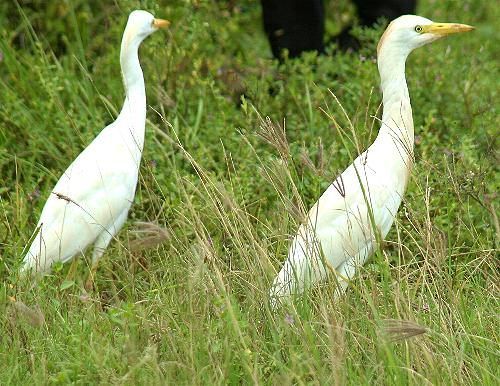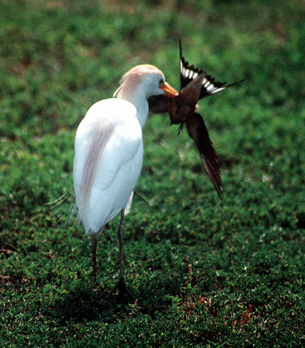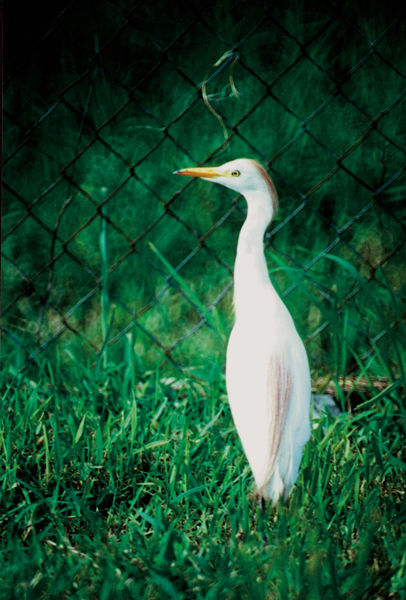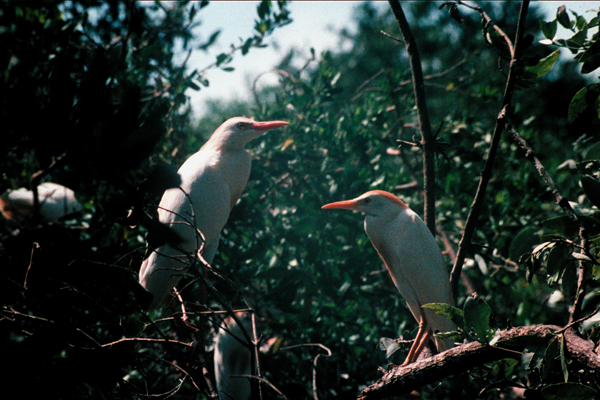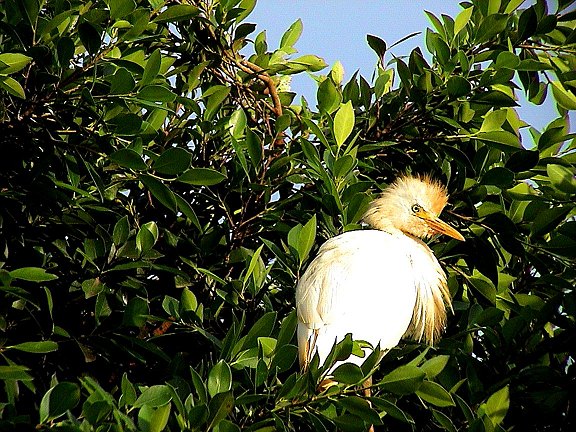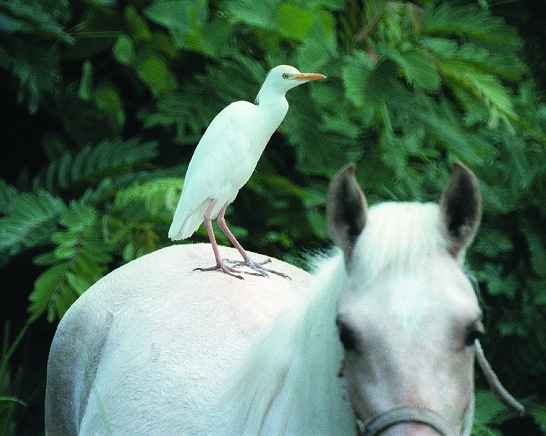|
Cattle Egret Bubulcus ibis Garza del Ganado,
|
 |
|
Breeding plumage - Photo: A. Sánchez Muñoz |
|
IDENTIFICATION: A small, white heron with a thick, yellow bill. In breeding season, it develops bright rufous feathers on the head and back. Its wing beat is faster and shallower than that of other herons and egrets. Length: 45-56 cm.; weight: 270-512 g. VOICE: Usually silent away from nesting colonies. Audio (M. Oberle). HABITAT: Typically in pastures, fields, grassy roadsides, municipal landfills. It has also been observed foraging in shallow estuaries, lagoons, tidal pools and along rocky coastlines. HABITS: The Cattle Egret forages alone or in flocks near farm animals, especially cattle and horses, where it plucks insects stirred up by the large mammals. Besides grasshoppers, crickets, and other insects, it also eats lizards, frogs, crayfish, centipedes, spiders, and the eggs and chicks of other birds when the opportunity arises. Large flocks feed on food scraps at garbage landfills. It sometimes rides on the back of a cow or horse for short distances, and will flock around farm equipment that flushes insects and other prey from fields. Large flocks roost in trees at night: these roosts can be seen from far away, looking like lit-up Christmas trees. At dawn, small flocks disperse from the roosts to feeding grounds sometimes several kilometers away. In the breeding season the Cattle Egret forms large colonies---often with other heron species---in mangroves or wooded swamps. The male attracts a female to a small treetop breeding territory and ceremoniously brings her twigs for nest building. The female constructs the nest, and lays 3-4 light blue eggs. Both sexes share incubation duties for 22-25 days. Both sexes brood and feed the young, and will also shade the chicks during the mid-day heat for the first 10 days. When a parent arrives at the nest, the oldest chick grabs the parent’s bill and the parent regurgitates food. Chicks often fight each other, and squabble over food. The two oldest chicks usually win these fights, and on rare occasions, they even kill a younger chick. The older chicks may have an additional advantage besides size: the egg yolks of the two older chicks have higher levels of androgen hormones that promote aggressiveness. At about two weeks of age, some chicks leave the nest and beg for food from nearby branches. Chicks fledge at about 30 days of age, and forage on their own at about 60 days. The Cattle Egret starts to breed at about two years of age. One bird in North America was recovered 17 years after being banded, although most egrets may not live that long. After the breeding season, Cattle Egrets disperse widely. For example, egrets from eastern North America winter in Florida, Central America, and the Caribbean. Birds that breed in the Caribbean also disperse after breeding. In one study, Cattle Egrets banded on the nearby island of Guadeloupe were recovered on 13 other islands from Barbados to the Florida Keys. STATUS AND CONSERVATION: Common, permanent resident of Puerto Rico. The Cattle Egret’s range expanded dramatically over the last century. It occasionally crosses the southern Atlantic Ocean from Africa to South America. It became an established breeder in northern South America by about 1930. The Cattle Egret then dispersed farther north, possibly in the company of migrating, native herons. It reached Puerto Rico by 1948, then the Bahamas, and then began to colonize North America. By 1981, wandering juvenile Cattle Egrets had reached Alaska, and, by 1977, the species had been reported from as far south as Tierra del Fuego. One theory is that the Cattle Egret, like other herons, often crossed the Atlantic from Africa, but that only in the last century has it been able to establish itself thanks to the expansion of ranching. This species has flourished thanks to the introduction of livestock to Puerto Rico, and the expansion of open pastureland and agricultural fields. The Cattle Egret benefits farmers by controlling insect pests around livestock. RANGE: Breeds from southern Canada south to central Argentina and Chile; and in the Old World, through parts of Africa, southern Europe, and southern Asia to Australia. But it wanders widely and has been seen on every continent, even in the Arctic and Antarctic. A common sight in open country throughout Puerto Rico. TAXONOMY: CICONIIFORMES; ARDEIDAE |
|

